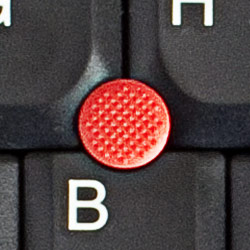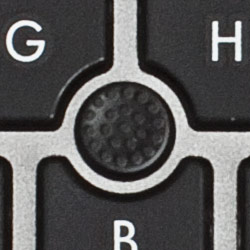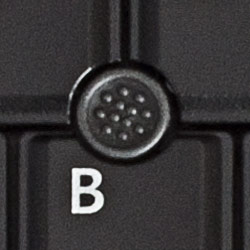Looking for Nub: Best and Worst Notebook Pointing Sticks
Notebook pointing sticks? I'm in nub with them. Call me old-fashioned, stubborn, or stuck in the "PC era," but when I'm using my notebook, I want the most accurate navigation tool possible, one that lets me do my work as quickly and efficiently as possible. That tool is not the ubiquitous touchpad, but the little rubber pointing stick that sits between the G and H keys on some business notebooks, most famously Lenovo's ThinkPad line.
Pointing sticks are still far better than today's touchpads for a couple of reasons. First, there's no chance of jumpiness or interference with a pointing stick, because the isometric joystick below the little dome is directly linked to hardware. Touchpads, on the other hand, use capacitive touch technology that can suddenly jerk your pointer around if your finger emits too much current or one of the notebook's components delivers a competing signal.
Second, there's no "dead zone" with a pointing stick like you experience when your finger runs off the edge of a touchpad. Even better, touch typists like me don't have to lift our hands off of the homerow to use a pointing stick, allowing us to work faster and put less strain on our wrists and shoulders.
Despite these obvious advantages, notebook vendors have convinced themselves that pointing sticks are too scary for the masses, so they've limited their deployment to a handful of business laptops. In addition to Lenovo's ThinkPads and their red "TrackPoints," there are pointing sticks on Dell's Latitude series, HP's EliteBooks, and certain Toshiba Tecras. As with all notebook components, they're not created equal. So whose stick sticks it to the others? I decided to do some testing.
First Place: Lenovo TrackPoint
Lenovo's TrackPoint is still the gold standard: comfortable, accurate, and pleasant to touch. The cap is nice and wide at over 4mm and sits ever-so-slightly above the key level.
I particularly like the bumpy, raised surface -- which Lenovo compares to a cat's tongue -- on the standard TrackPoint cap. If you don't like that particular texture, the company sells two other styles of replacement cap: classic dome and soft dome.
Sign up to receive The Snapshot, a free special dispatch from Laptop Mag, in your inbox.
Second Place: Toshiba Tecra R Series AccuPoint
Dubbed the AccuPoint, Toshiba's slate blue pointing stick was extremely accurate and smooth in my testing. I love the slightly-rough surface on the cap, because it's easy to grip, but some users will definitely find it too sandpaper-like and a bit too narrow.
Unfortunately, the 1mm cap is significantly narrower than those on other notebooks and a little bit lower than it should be. The company also failed to include a scroll button like you'll find on its Dell and Lenovo competitors. Note that the AccuPoint isn't even available on every Tecra model.
Buck up, Toshiba, because you've got a good thing going here, if you'd only believe in it.
Third Place: HP Elitebook with Synaptics TouchStyk
On its EliteBook line, HP takes its stick from Synaptics, which calls the nub a TouchStyk. On the EliteBook 8460p I tested, the stick was nicely positioned in a wide open space between the island-style G, H, and B keys. Elevated higher than key level, the 4mm wide TouchStyk was easy to grip.
However, its concave surface and sharp dots were a bit uncomfortable to use and made impressions on the surface of my index finger. The stick also feels a little bit stiffer than its Lenovo and Toshiba counterparts. Still, I was impressed with HP's implementation overall. I just wish I could just swap the cap for one that has an upward-arching, convex dome.
Last Place: Dell Latitude Pointing Stick
Imprint on my finger and this Latitude's to blame, Dell gives nubs a bad name. The 3mm pointing stick on Dell's notebooks has sharp, raised points that sit inside the stick's concave surface, which itself sits lower than key level. This means that you have to push downward to use the stick. In my testing, my finger kept coming off the low-sitting cap, and I had to press so hard that I ended up with indentations on my finger from the sharp tendrils on the cap.
The only thing Dell's pointing stick has going for it is a scroll button that lets you move up and down web pages.






